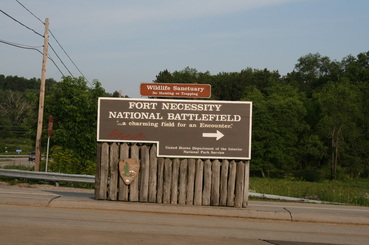Fort Necessity, Fayette County, PA
by Andy Hagerty
|
In the years leading up to 1754 and the start of hostilities in north America, there was already plenty of hostility. The French by virtue of De La Salle claimed most of the center of the continent, including the critical Forks of the Ohio ( present day Pittsburg, PA.). The British also wanted these valuable lands and were looking to push out that way. Of course there were the actual native tribes of the area who for some reason thought that they should control the land as they had lived there before either the French or British ever showed up.
The Forks of the Ohio was thought to be part of the Land claim given to to Virginia by the king. To support this claim, Virginia Governor Robert Dinwiddie dispatched a construction party to build a fort. thinking about it a bit more he later dispatched Lieutenant Colonel George Washington and 159 militia to the building site. Although the exact details are going to be discussed under a different fort name, the French took a larger force and had this building party move on, then using the tools the British had lugged across the country, began to build their own fort, Fort Duquesne. By the time Washington had arrived with his force the British had already retreated to an area called the Great Meadows. |
Not to be deterred from his orders, he set up camp in the great meadows and started scouting the area. He was alerted to an approaching French and Indian scout force by the Mingo, Tanacharison (also known as Half King), who had allied his tribe with the British. George promptly marched 40 of his men through the rainy night and set up an ambush around the French troops who had camped in a ravine. the Ambush was a success as 10 French were killed and 21 captured with few British losses. In the aftermath of the battle, as Washington was interrogating the French leader, Joeseph Coulon de Villiers de Jumonville, Half King came up and struck the Frenchman in the head, killing him.
|
Figuring this battle and subsequent killing would annoy the French, Washington fell back to the Great Meadows. He then started construction of a log palisade on the 29th of May. this Fort was to be called Fort Necessity. He placed the fort in the center of the meadow, believing that would provide a clear fields of fire for his men. However, the location was in a depression and too close to the tree line.
On June 9, additional troops from Washington's Virginia regiment arrived bringing his total force up to 293 men. The stage was almost set. |
There are handy pictures of the tree line as it was in 1754
|
On June 14th Captain James McKay arrived with his Independent Company of regular British troops from South Carolina. The addition of 100 men was mitigated by a command issue. The issue was even though Washington had a higher Rank, McKay's commission in the British Army took precedence. The two ultimately agreed on an awkward system of joint command. this was the situation at the end of the month, when news of a large French force was reported advancing upon the fort.
A force of 600 French and 100 Indians had departed Fort Duquesne and marched southeastward. On July 3, the French, led by Captain Louis Coulon de Villiers, Jumonville's brother, arrived and quickly surrounded the fort. Taking advantage of Washington's mistake, they occupied high ground along the tree line which allowed them to fire into the fort. The French Commander was outraged by the murder of his brother pressed his attack.
Pinned down, Washington's men soon ran short of ammunition. To make their situation worse, heavy rain began which made firing difficult. Around 8:00 PM, Villiers sent a messenger to Washington to open surrender negotiations. With his situation hopeless, Washington agreed. He signed the surrender document on the 4th of July anfter a long night of negotiations. The document, written in French, included one section where Washington "confessed" to the Murder of the Joeseph Coulon de Jumonville. When he was appraised of this later on, he protested stating he would have never signed the surrender had he know that clause was in there.
The French occupied the fort, then burnt it to the ground and returned back to Fort Duquesne. For now the French reigned in the Ohio and western Pennsylvania, soon that would be challenged by the largest British Expedition in north America up till that time.
A force of 600 French and 100 Indians had departed Fort Duquesne and marched southeastward. On July 3, the French, led by Captain Louis Coulon de Villiers, Jumonville's brother, arrived and quickly surrounded the fort. Taking advantage of Washington's mistake, they occupied high ground along the tree line which allowed them to fire into the fort. The French Commander was outraged by the murder of his brother pressed his attack.
Pinned down, Washington's men soon ran short of ammunition. To make their situation worse, heavy rain began which made firing difficult. Around 8:00 PM, Villiers sent a messenger to Washington to open surrender negotiations. With his situation hopeless, Washington agreed. He signed the surrender document on the 4th of July anfter a long night of negotiations. The document, written in French, included one section where Washington "confessed" to the Murder of the Joeseph Coulon de Jumonville. When he was appraised of this later on, he protested stating he would have never signed the surrender had he know that clause was in there.
The French occupied the fort, then burnt it to the ground and returned back to Fort Duquesne. For now the French reigned in the Ohio and western Pennsylvania, soon that would be challenged by the largest British Expedition in north America up till that time.



